The grayling, in the past often maligned as vermin on trout rivers, is at last being recognised as a truly sporting and wild fish.
The fact that their season continues after the close of trout fishing, and that they take a fly readily, reinforces their attraction to the thinking, sporting angler.
A surge of interest has taken place in recent years, starting slowly back in the 1970's with the publication of Reg Righyni's classic book `Grayling', and the formation of the Grayling Society, and continues to gather momentum today, as ever more fishermen pursue this most attractive and elegant fish.
Distribution in the South West
The Wessex region is home to some fine grayling, with the Wiltshire/Hampshire Avon system probably having the densest population in Britain. The Frome holds some very large fish, certainly in the 31b class, mostly downstream of Dorchester. I believe there are grayling in the Tone, then moving west into Devon and Cornwall we have two isolated but thriving populations in the Exe and Tamar systems. On the Exe they can be found all the way up from Exeter to the Barle junction and into the lowest pools on the Barle. On the Tamar they are well distributed throughout the main river and most of the tributaries, particularly the Inny, Lyd and Ottery. In was on the upper reaches of the Inny, on a cold, grey day in March 1967, that I saw my very first grayling, and I have been fascinated ever since by "The lady of the stream".
Tackle
A light, crisp actioned fly rod of around 9 feet, matched with a floating line no heavier than AFTM 5, is perfect for most waters. I prefer a double tapered line, it allows a more
delicate presentation and is more suited to roll casting, often essential on small streams. The reel should be a light nononsense job, well filled with line and backing, not for playing the fish but to minimise line coil and memory. I needle knot a 9ft knotless tapered leader (31b of 5x) and add 3 feet of 21b nylon as a tippett, attached with a three turn water knot. Waders are useful, with chest waders preferred. You will need all the other accessories you would normally carry when trouting, floatant, sinkant etc. Most essential though is a pair of long nosed forceps of similar to facilitate unhooking and returning your fish. Hooks should be barbless, I often catch salmon parr, unseasonable trout and even sea trout whilst fishing for grayling.
Tactics
First, find your fish! On the clear waters of the Wessex trout streams careful observation with polaroids will soon reveal the fish. Grey shadows on the river bed, ever on the move to intercept a drifting nymph or lumbering caddis. Rising fish are on obvious give away, but are they grayling? or perhaps brown trout or salmon parr. The rise of a grayling can be seen to be slightly different to other game fish, due to the grayling's unique habit of lying hard on the river bed and rising almost vertically to the surface to engulf it's prey, and returning at once to the gravel. This causes the fish to make an oily, kidney shaped whorl on the surface of the water, often accompanied by a bubble as it turns a sort of somersault on it's way back to the river bed. In clear water the fish can often be seen emerging from the depths like a missile a split second before breaking the surface. In the absence of fly hatches and rising fish the only way to find your grayling is to fish all the likely looking areas and, once a fish has been landed, cover the area thoroughly as grayling often shoal. As the trout season ends and the water temperature drops this shoaling behaviour becomes more apparent, with some parts of the river completely devoid of fish, so it pays to know the sort of water the grayling prefer. Local advice and information can be invaluable, but if none is available look for steady, even flowing water of between 18 inches and 6 feet in depth, the colder the water the deeper the fish will be.
Wet and Dry Fly
Small wet trout flies, fished either up or downstream will take grayling in summer and early autumn, but are indiscriminate and far less efficient than dry fly or nymph.
A hatch of naturals, in any month of the year will bring grayling to the surface and provide superlative sport on a dry fly. The grayling is a fussy feeder and any untidy presentation will result in the fly being refused. From it's position on the river bed the grayling has a wide field of view, so the fly should land without disturbing the water and drift for several feet without dragging, in order to deceive her ladyship.
Fly patterns are less important than presentation, though if the insect on the water can be identified and matched by a suitable artificial, so much the better. Grayling will often feed on tiny flies and your box should contain a selection from size 12 down to 18 or 20. Despite taking tiny flies it is not unusual to catch grayling while spinning for salmon with a small Mepps and my biggest grayling, a two pounder, took a large lure at night while I was after sea trout! Many of the traditional grayling flies are still highly successful today. Fancy patterns such as Red Tag, Treacle Parkin and Bradshaw's Fancy are excellent. The modern range of cul-de-canard flies, with their highly imitative properties, are very hard to beat. The flies visibility to the angler is also very important, particularly in the fading light of and October or November afternoon. I like parachute style flies with a highly visible wing post of white calf tail or synthetic wool, the American elk hair caddis is also highly visible and can be very effective, even when caddis flies are absent. Grayling take a fly very quickly and your strike must be equally rapid if you are to hook your fish.
Nymph Fishing
There will, of course, be times when there are no naturals hatching and the surface of the river slides past unbroken by the rings of rising fish. Now is the time for the nymph, without doubt the most effective way of catching grayling. The late Frank Sawyer, river keeper on the officer's club water on the Wiltshire Avon at Netheravon, invented his famous killer bug purely as a way of catching and removing unwanted grayling from a trout fishery. On the chalk streams where the clear water allows fish to be stalked and targeted, cast your weighted nymph upstream of the fish and allow it to drift downstream, keeping an eagle eye on the point where your leader penetrates the surface film. It pays to grease the leader down to the tippet knot and sink the tippet with fullers earth. When the fish takes the knot will twitch or be pulled under and your strike must be instantaneous. If a fish keeps refusing your fly try the `induced take' by lifting the rod just before the nymph reaches the fish. This lifts the nymph enticingly just in front of the fish's nose and few grayling can resist it.
When the fish are not visible I use an indicator on the leader, either a tuft of wool treated with floatant or a pea-sized lump of Float-do or similar material. The position of the indicator determines the depth at which the nymph will fish and, crucially, indicates the take. Obviously a heavy nymph is needed to fish deep water and I am a great fan of the bead headed types. Gold and copper heads work well on most patterns such as hare's ear, pheasant tail and even the original killer bug.
Caution and Conservation
Grayling share their habitat with trout and salmon which spawn during the autumn months. CHECK with the owners of the fishery to see whether fishing for grayling is allowed after the close of the salmon and trout seasons. More importantly, if you can fish, DO NOT WADE anywhere near the pool tails between October and March. Fertile trout and salmon eggs will be buried in the gravel shallows and walking on them will damage our fish stocks for future years.
I would like to close with a word on conservation. At one time grayling were ruthlessly culled from trout streams by any means possible. This has been proven an ineffective as a way of reducing numbers and just reduces the average size of fish. Today most fisheries value the presence of grayling, they are an excellent indication of good water quality and happily co-exist with other game fish. In early autumn, when in their prime, grayling make excellent eating, but only take what you need (they are protected by law through the coarse fish close season, 16 March to 15 June inclusive and other bylaws may apply).
All out truly wild fish stocks are under threat these days and it would be nice to see anglers actively caring for the grayling and the rivers they inhabit.
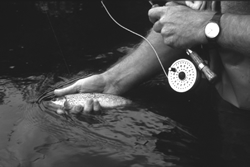 For the fly fisher who seeks nothing more than a sparkling stream to explore for a trout the South West is a wonderful place. Whether the moorland rivers of Dartmoor and Exmoor or the silky chalk streams of Wessex, this is a region with endless opportunities and challenges, not only for the dedicated river angler but also for many reservoir fishers who head south west for a different experience.
For the fly fisher who seeks nothing more than a sparkling stream to explore for a trout the South West is a wonderful place. Whether the moorland rivers of Dartmoor and Exmoor or the silky chalk streams of Wessex, this is a region with endless opportunities and challenges, not only for the dedicated river angler but also for many reservoir fishers who head south west for a different experience.
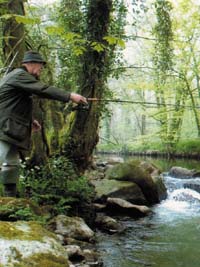
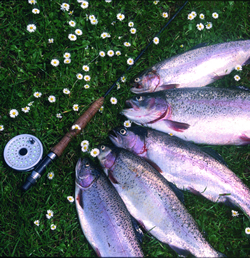 When the editor of Get Hooked asked me to come up with a dozen trout flies for all waters – both rivers and lakes – my reaction was something between incredulity and panic. A quick look at a couple of my fly boxes revealed dozen of patterns and I am sure that I could have produced a good reason for including every one of them. But a closer look revealed that a much smaller number showed the wear and tear of frequent use, while perhaps the majority were still in a relatively pristine state. So, perhaps the range of flies that catch most of my trout is rather narrower than the contents of the fly boxes would at first suggest.
When the editor of Get Hooked asked me to come up with a dozen trout flies for all waters – both rivers and lakes – my reaction was something between incredulity and panic. A quick look at a couple of my fly boxes revealed dozen of patterns and I am sure that I could have produced a good reason for including every one of them. But a closer look revealed that a much smaller number showed the wear and tear of frequent use, while perhaps the majority were still in a relatively pristine state. So, perhaps the range of flies that catch most of my trout is rather narrower than the contents of the fly boxes would at first suggest.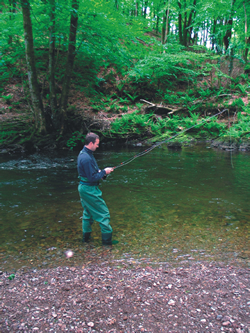 Not so long ago, my river fishing was restricted to Saturday afternoons, having worked ‘up country’ from Monday to Friday. Those few precious hours were enough to completely de-stress me as everything in my head, except the job in hand, melted away. This is stress busting at its best and should really be available on the NHS.
Not so long ago, my river fishing was restricted to Saturday afternoons, having worked ‘up country’ from Monday to Friday. Those few precious hours were enough to completely de-stress me as everything in my head, except the job in hand, melted away. This is stress busting at its best and should really be available on the NHS.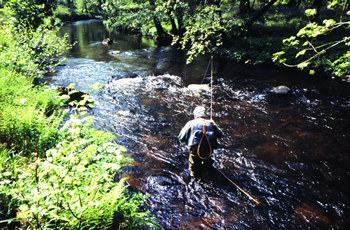
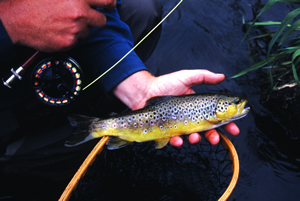 Taking advantage of advances in tackle is key to success, and developments in rods, lines, leaders and flies have all contributed to making it possible to go out with every expectation of success on a bright summer day. Terminal tackle took a great leap forward with the introduction of ultra-fine nylon for the point of your leader, light-weight rods with real power have become the norm as a result of carbon fibre, tiny nymphs sink quickly thanks to bead heads, and breathable waders make it possible to fish though the day without succumbing to heat stroke.
Taking advantage of advances in tackle is key to success, and developments in rods, lines, leaders and flies have all contributed to making it possible to go out with every expectation of success on a bright summer day. Terminal tackle took a great leap forward with the introduction of ultra-fine nylon for the point of your leader, light-weight rods with real power have become the norm as a result of carbon fibre, tiny nymphs sink quickly thanks to bead heads, and breathable waders make it possible to fish though the day without succumbing to heat stroke.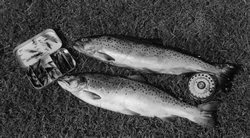 The Editor has requested that I do an article on Sea Trout fishing in Devon hence the title. It would be easy for me just to write a few paragraphs on my own experiences of fishing the Teign, Taw, Torridge, Mole or Dart and leave the reader with the feeling of ‘oh what a lucky bugger he is doing this for a living’, but you will be pleased, I hope, to read that’s not what this article is about.
The Editor has requested that I do an article on Sea Trout fishing in Devon hence the title. It would be easy for me just to write a few paragraphs on my own experiences of fishing the Teign, Taw, Torridge, Mole or Dart and leave the reader with the feeling of ‘oh what a lucky bugger he is doing this for a living’, but you will be pleased, I hope, to read that’s not what this article is about.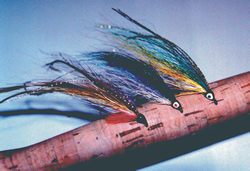
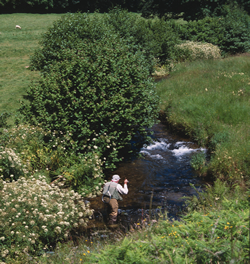 There is something a bit special about tiny streams, especially for the wild trout fisherman. Our native wild brown trout is ideally suited to thrive on the smallest rivers and fortunately the south west has more than its share of these exciting waters, whether high on Dartmoor, Exmoor or Bodmin Moor, among the meadows of the rolling country of mid Devon or on the silky little chalk streams of Wessex.
There is something a bit special about tiny streams, especially for the wild trout fisherman. Our native wild brown trout is ideally suited to thrive on the smallest rivers and fortunately the south west has more than its share of these exciting waters, whether high on Dartmoor, Exmoor or Bodmin Moor, among the meadows of the rolling country of mid Devon or on the silky little chalk streams of Wessex.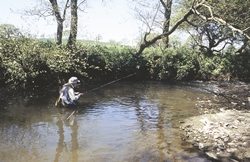 The margin between success and relative failure in fishing can be very small and this is particularly so in the case of the type of angling that I enjoy most – fly-fishing for trout on rivers. Indeed, there is an old saying that ten per cent of the fishermen catch ninety per cent of the fish and, although this sentiment may include a degree of exaggeration, it is probably pretty close to the truth. So, if you wish to join that small percentage of really successful fly fishers and clean up on the streams, what can you do to achieve success? Many anglers never get past the barrier of thinking that there is a single key to success and that a wonder fly rod or an irresistible fly will guarantee a constant flow of trout coming to the landing net. Fortunately there is no such “magic bullet” and if there were fishing would soon lose most of its fascination. Success, when it comes, is the result of getting lots of little things right, so here are a few tips to increase your strike rate with the trout on our rivers.
The margin between success and relative failure in fishing can be very small and this is particularly so in the case of the type of angling that I enjoy most – fly-fishing for trout on rivers. Indeed, there is an old saying that ten per cent of the fishermen catch ninety per cent of the fish and, although this sentiment may include a degree of exaggeration, it is probably pretty close to the truth. So, if you wish to join that small percentage of really successful fly fishers and clean up on the streams, what can you do to achieve success? Many anglers never get past the barrier of thinking that there is a single key to success and that a wonder fly rod or an irresistible fly will guarantee a constant flow of trout coming to the landing net. Fortunately there is no such “magic bullet” and if there were fishing would soon lose most of its fascination. Success, when it comes, is the result of getting lots of little things right, so here are a few tips to increase your strike rate with the trout on our rivers.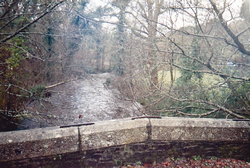 The River Fowey is a prime Cornish spate river giving excellent salmon and seatrout fishing. It is one of only two rivers in the south west of England holding its targets for sustainable salmonid stocks.
The River Fowey is a prime Cornish spate river giving excellent salmon and seatrout fishing. It is one of only two rivers in the south west of England holding its targets for sustainable salmonid stocks.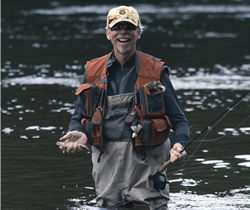 Tucked away, in this comparatively small island, are still places, mercifully, where footprints are few. Places where you can, just for a moment, rejoice in wild company and glimpse at a less populous past. Most of these are situated westerly: and a very unfair proportion can be found in the West Country: damn it! I say this, because I am a long way away and I can’t fish the huge variety of waters and diversity of species that this area has to offer, as much as I would like. I guess this makes the experience all the richer. I think too, that taking the West Country, as a whole is just a little misleading. Do we talk about the imperious coast-line and the wolf of the waves: bass? The more languid mullet or wrasse? Do we talk about the brutes of the channel wrecks and deep sea water?
Tucked away, in this comparatively small island, are still places, mercifully, where footprints are few. Places where you can, just for a moment, rejoice in wild company and glimpse at a less populous past. Most of these are situated westerly: and a very unfair proportion can be found in the West Country: damn it! I say this, because I am a long way away and I can’t fish the huge variety of waters and diversity of species that this area has to offer, as much as I would like. I guess this makes the experience all the richer. I think too, that taking the West Country, as a whole is just a little misleading. Do we talk about the imperious coast-line and the wolf of the waves: bass? The more languid mullet or wrasse? Do we talk about the brutes of the channel wrecks and deep sea water?